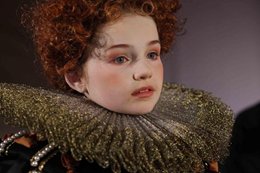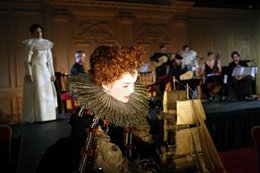"Renaissance Cabaret Oratorio". It's a curious tag to hang around a new piece of work, and a safe bet that it has never previously been utilised in the entire history of music theatre. It’s nonetheless a fair summary of the various strands of influence which have gone into the making of Shipwrecked, a hybrid production telling the true story of Francisco de Cuéllar, a Spanish Armada captain whose ship foundered in 1588, in a hurricane off Streedagh Strand near Sligo. De Cuéllar subsequently spent seven months on the run from English occupiers, engaging in a series of picaresque adventures among the native Irish, whom he pointedly refers to as "savages" in his narration.
 The structure of Shipwrecked resembles that of a stage musical: blocks of text punctuated by dance and musical numbers, both vocal and instrumental, delivered by seven members of the early music ensemble eX and a trio of excellent solo singers. Three members of the ensemble have non-singing roles: two children (Abby Phillips and Adam Maloney) in the peripheral roles of the English and Spanish monarchs, and Oscar Hernandez in the central part of de Cuéllar, the landlocked Spanish fugitive.
The structure of Shipwrecked resembles that of a stage musical: blocks of text punctuated by dance and musical numbers, both vocal and instrumental, delivered by seven members of the early music ensemble eX and a trio of excellent solo singers. Three members of the ensemble have non-singing roles: two children (Abby Phillips and Adam Maloney) in the peripheral roles of the English and Spanish monarchs, and Oscar Hernandez in the central part of de Cuéllar, the landlocked Spanish fugitive.
Musically there is much to enjoy in the production. The three solo singers in particular (mezzo Caitríona O’Leary, soprano Clara Sanabras and tenor Julian Podger) bring quality and sophistication to their contributions, which draw mainly from vocal music of the Spanish baroque period and Irish traditional sources. Problems arise, however, when you try linking the show's “soundtrack” (as music director O’Leary terms it) with what is happening on the stage dramatically. De Cuéllar’s narrative (based on a letter he wrote describing his adventures) is full of colourful incident and anecdote, but there's often a bemusing sense of dislocation between what he's relating and the piece of music chosen to illustrate the story, or advance it further.
The nub of the issue is that too often you're left admiring, say, the undeniable beauties of a motet by Victoria, while at the same time wondering why it's been inserted at that particular point in the evening. The fact that most of the vocal numbers are in either Spanish, Latin or Irish slips a further layer of obfuscation between the performers and the audience.
Other factors diluted the impact of the show on the evening I saw it. Oscar Hernandez’s performance in the central role of de Cuéllar had an endearing warmth and charm about it, but his Hispanicised English, though in some ways enhancing verisimilitude, made it difficult to decipher what he was saying in places. And while stringed instruments can certainly be difficult to keep on pitch in theatre conditions, it didn't help to see and hear the on-stage gambist tuning his instrument more than once as Hernandez delivered his narration.

.jpg.aspx)
 Communication issues also to some extent compromised the generally excellent work of the eX instrumentalists, one of whom (Steve Player, a guitarist) stepped forward on several occasions to perform elegant, jig-type dances in the sections where de Cuéllar is carousing with the local people. The location of the instrumentalists towards the rear part of the stage area, however, muted the impact of what they were playing, an effect possibly exacerbated by the fairly dry Solstice theatre acoustic. Period instruments (viola da gamba, lute, and cittern were among those featured) are more lightly stringed than their modern counterparts, and therefore quieter: they need more sympathetic positioning, especially when there is only a small number of them. Cormac Veale’s lighting was soft, discreet, and effective, Alessio Rosati’s costumes generically of the period, and neatly appropriate. Rosati also designed the set, which had an antique writing table for de Cuéllar to sit at, and two simple thrones for the child-monarchs, but was otherwise suitably minimalist.
Communication issues also to some extent compromised the generally excellent work of the eX instrumentalists, one of whom (Steve Player, a guitarist) stepped forward on several occasions to perform elegant, jig-type dances in the sections where de Cuéllar is carousing with the local people. The location of the instrumentalists towards the rear part of the stage area, however, muted the impact of what they were playing, an effect possibly exacerbated by the fairly dry Solstice theatre acoustic. Period instruments (viola da gamba, lute, and cittern were among those featured) are more lightly stringed than their modern counterparts, and therefore quieter: they need more sympathetic positioning, especially when there is only a small number of them. Cormac Veale’s lighting was soft, discreet, and effective, Alessio Rosati’s costumes generically of the period, and neatly appropriate. Rosati also designed the set, which had an antique writing table for de Cuéllar to sit at, and two simple thrones for the child-monarchs, but was otherwise suitably minimalist.
I was, ultimately, left wondering what Shipwrecked was actually intended to be in the minds of those who conceived it. A straightforward, swashbuckling adventure story? If so, it simply wasn't exciting enough. A light-hearted examination of contrasting national cultures? Not really - thematically that idea was present, but never developed to the extent of actually making the audience think more than fleetingly about it. A sixteenth century political intrigue, with injections of comic incident enlivening the serious content? Again, the politics were hinted at, then glossed over superficially.
The truth is that Shipwrecked, despite the frequent excellence of its individual performances, is stymied from the outset by failing to define its dramatic targets clearly enough. As music theatre it’s only fitfully coherent; as entertainment pure and simple it pleases intermittently, but lacks that sense of gradually accumulating enjoyment and edification that a really well-structured evening in the theatre can generate. The ingredients are good, occasionally excellent, but they needed more careful, considered preparation and cooking.
Terry Blain is an arts journalist and cultural commentator, contributing regularly to BBC Music Magazine, Opera Britannia, Culture Northern Ireland and other publications.